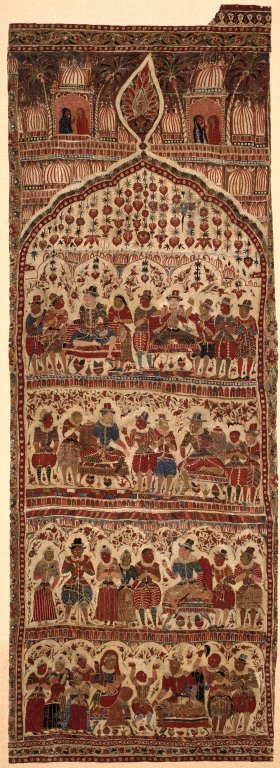Chintz of Golconda : paintings on cloth

Kalamkari wall hanging, early 17th century.
By Online Collection of Brooklyn Museum; Photo: Brooklyn Museum, 14.719.2_SL1.jpg, Public Domain, https://commons.wikimedia.org/w/index.php?curid=10195568

Curtain for a royal tent (qanat) from Andhra Pradesh or Tamil Nadu region, 1665.
By Hiart - Own work, CC0, https://commons.wikimedia.org/w/index.php?curid=53643424
References :
Posted by :
Soma Ghosh
©author
The kingdom of Golconda was a trading centre for diamonds,gems and textiles. They patronised Kalamkari of Machilipatnam, a hand-painted craft during the 16th and 17th centuries. The textiles were made for the Sultanate of Golconda and Iran/Persia. The designs were customised to the Islamic taste. The art of Kalamkari had evolved wherein the artist works with a pen or qalam; this art flourished in Srikalahasti too where temple hangings were made and in Machilipatnam in South India, as already mentioned. The English called it chintz, the Dutch called sitz, the Portugese pintado. with time all cloth with patterns came to be known as chintz. The Srikalahasti kalamkaris had an almost religious identity; scenes from the Hindu epics like Ramayana, Mahabharata were made for scrolls,chariot banners etc.These were completely hand-worked.
The kalamkari techinique used the qalam to trace patterns on the cloth. Vegetable and natural dyes extracted from parts of plants like roots,leaves and mineral salts of iron,tin, copper etc. were then filled to create the final product. The artist was called qalamkar. Kalamkari thus literally means, art work done using a pen. In Machilipatnam hand-carved block prints were used. Finer details were made with qalam.
The Machilipatnam artists made prayer mats, wall hangings,curtains,cloth belts etc. The designs included the cypress tree,mihrab (prayer niche) of a mosque and animals mentioned in Islamic writings. Floral patterns were much in use for many creations made for both the Europeans,for Persia and the Golconda kingdom. The tree of life is also a common theme. Human figures were also depicted.
The wall hanging depicted below has five panels within a floral pattern framework. Floral designs can be seen within the panels too. The scenes depict Europeans and locals.
There are two mandapas on top with two women in each. There are onion shaped domes above the arch; the wall hanging depicts multi-cultural character.

Kalamkari wall hanging, early 17th century.
By Online Collection of Brooklyn Museum; Photo: Brooklyn Museum, 14.719.2_SL1.jpg, Public Domain, https://commons.wikimedia.org/w/index.php?curid=10195568
The creation below is a qanat or a curtain for a tent, with exquisite floral design. The main design, a flowering plant, is in the middle with smaller flowers used in the multi-layered frame around it.

Curtain for a royal tent (qanat) from Andhra Pradesh or Tamil Nadu region, 1665.
By Hiart - Own work, CC0, https://commons.wikimedia.org/w/index.php?curid=53643424
References :
- wikipedia.org
- The heritage of the Qutb Shahis of Golconda and Hyderabad/Nayeem,M.A,Hyderabad : Hyderabad Publishers,2006.
Posted by :
Soma Ghosh
©author



No comments:
Post a Comment